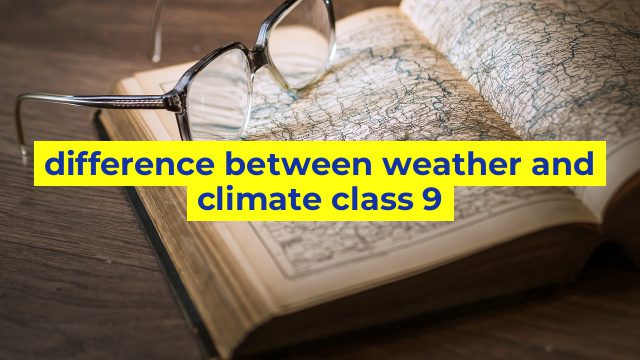Understanding the Difference between Weather and Climate: A Class 9 Perspective
Introduction
As a student in class 9, you may have heard the terms “weather” and “climate” being used interchangeably. However, they are two distinct concepts and understanding their differences is crucial.
Defining Weather
Weather refers to the atmospheric conditions in a specific location over a short period, usually hours or days. It is affected by factors such as temperature, precipitation, wind, and humidity. For example, if it is sunny and hot outside today, that is the weather.
Defining Climate
Climate is the average pattern of weather in a particular location over a longer period, typically 30 years or more. Climate is determined by various factors, including latitude, altitude, ocean currents, and air masses. Weather events can influence climate change, but climate change takes place over a more extended period.
Distinguishing between Weather and Climate
The essential difference between weather and climate is the length of time they cover. While weather talks about short-term atmospheric conditions, climate refers to long-term patterns of weather in a location. Weather is unpredictable and can change from minute to minute or hour to hour, while climate follows a more predictable pattern and changes gradually over time.
Importance of Weather and Climate Differences
Understanding the difference between weather and climate is essential in various fields. Meteorologists, scientists, and farmers rely on weather forecasting to plan and prepare for specific events. On the other hand, decision-makers, policymakers, and environmentalists use climate data to predict long-term environmental patterns and come up with strategies to mitigate climate change.
Conclusion
In conclusion, class 9 students should learn the difference between weather and climate as it is essential to understand the natural world’s complexities. By doing so, students can broaden their knowledge in various fields and appreciate the roles that both weather and climate play in shaping our planet.
Table difference between weather and climate class 9
| Aspect | Weather | Climate |
|---|---|---|
| Definition | The state of the atmosphere at a particular time and place, including temperature, precipitation, and wind. | The average weather conditions in a particular place over a long period of time, often referred to as 30 years. |
| Timeframe | Short-term, usually measured in days or weeks. | Long-term, usually measured in decades or centuries. |
| Variability | High variability between days, and even within a single day. | Low variability, with gradual changes over time. |
| Impacts | Direct impact on daily activities such as planning outdoor activities and wearing appropriate clothing. | Indirect impact on the environment, ecosystems, and human societies. |
| Prediction | Predictions for the weather, even for the next few days, can be uncertain and subject to change. | Climate predictions are more reliable and can be used to inform long-term planning. |

